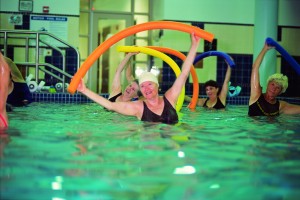As society continues to advance, so does our life expectancy. We often have the advantage of a long life, full of laughs, memories, and friendships. No bones about it, though. The older we grow, the more opportunities exist for the body to develop glitches. You know—the crick in your back, a stronger eyeglass prescription, and that weather-predicting elbow.
With the aging U.S. population, arthritis is on the rise. According to the Centers for Disease Control and Prevention (CDC), an estimated 46 million adults in the United States have this disease. By 2030, the number suffering from arthritis is expected to hit 67 million. It’s time to get proactive!

Your bones support the structure in which you reside. Help them stand tall and proud. Starting at a young age, consuming enough vitamin D and calcium helps build strong bones. As we age, it’s necessary to take additional measures for joint and bone health to reduce risk factors for arthritis, osteoporosis, and bone breaks that can land you in the hospital.
Drop the Pounds
Although injury, overuse, and genetics play a part in arthritis onset, weight often scores the leading role. Some experts blame obesity for the increased early onset of arthritis in today’s younger population. Obesity is a major risk factor for arthritis of weight-bearing joints, such as the knees and hips. Two-thirds of those currently diagnosed with arthritis are actually younger than 65 years. Additionally, those with arthritis exacerbate their condition if they are overweight, which can intensify symptoms and increase progression. The solution: maintain a healthy weight.
Visit the Center’s on-site nurse for a health assessment to determine your ideal weight. Share that information with a personal trainer and Group Fitness instructor. They can advise you of the ideal exercise methods and classes to safely accomplish your goals. Experts believe a loss of only 11 pounds can reduce the development of new knee osteoarthritis for some people. You may not have far to go.
Get Moving
When a sore body has you down, getting motivated to get up, let alone exercise, seems daunting. However, one of the best treatments for arthritis is a safe, effective exercise program. A sedentary lifestyle leads to increased pain, stiffness, inflammation, joint damage, physical limitation, and disability—even for the healthiest individuals.
Focus on low-impact activities so as not to harm joints that may already be achy or stiff. The Center offers special Group Fitness classes for those with issues such as arthritis, including Gentle Yoga. Yoga improves balance, which helps prevent falls. An added perk since falls can be especially dangerous for those with arthritis. Swimming and treadmill workouts are excellent.

Often, aquatic therapy is recommended for patients with arthritis. Warm water soothes aches and the buoyancy reduces strain on joints and bones. The Center’s extensive aquatic offerings include therapeutic programs. Surrounded by water, the body is relieved of stiffness. The entire skeleton is supported. Arthritic swimmers can more easily move their joints through the full range of motion. The Group Fitness schedule offers special programs for members with arthritis, including aquatic classes and events. Visit the Center’s Web site for specifics.
A personal trainer can create an exercise program that recognizes your current limitations and works toward overcoming them. Through functional training, those with arthritis can increase range-of-motion, reduce pain, and better perform everyday tasks. The support system of muscles around joints is strengthened as well as the bones. Breaking the cycle of pain, inactivity, and disability liberates the mind and body.
Beyond helping to lose weight, exercise often improves your sleep habits and your mood. Two factors that can help any condition.
Where to Start
Check with your physician before beginning fitness endeavors. You may have a therapeutic exercise program provided by a physical therapist. Continue performing any such activities while you gradually introduce new exercises to your regimen.
Pick a time of day when you feel your best. If you tend to experience early-morning stiffness, schedule workouts during lunchtime. If energy lags in the afternoon, try late morning or early evening after the body has a chance to limber up. Perhaps you have a bad bone day. It’s cold, rainy, and your pillows are soft. Give yourself the time to rest. A day off often rejuvenates the body and mind to start fresh the next day. It’s important that your workout does not feel like a chore. Consider it a positive habit toward a healthy lifestyle.
Listen to your body. Some discomfort during exercise is acceptable, signaling the body is being challenged. However pain, especially pain that lingers for hours beyond the exercise session, indicates the need to reduce intensity and duration. Avoid jerky movements and uneven breathing. Coordinate the flow of movements with the rhythm of breathing for a comfortable workout. If a joint feels hot or appears swollen, modify your routine until the flare-up passes.
Heat treatments–such as warm towels, hot packs, or a warm shower prior to exercising–can help relax muscles for a better workout. Be sure to avoid excessively hot temperatures though. Apply heat for about 20 minutes. Consider icing problem joints for 10 minutes after your workout. Always remember to warm-up and cool-down with proper stretching prior to any exercise.
Diabetes & Arthritis
Studies have revealed these two offenders often appear together. Two nationwide surveys completed by the CDC indicated that 52 percent of people ages 45-64 who have diabetes also have arthritis. Almost 28 percent of those ages 18-44 with diabetes also have arthritis. Weight issues possibly link the two, which means exercise can multitask in helping both!
Despite what seems a simple solution, many with these conditions suffer a double-whammy in their resistance to work out. Fluctuating blood-sugar levels from diabetes decreases energy levels. Combined with arthritis pain, these folks often hit the couch instead of the treadmill. The trick is to improve your diet and start exercise slowly. A nutritionist can recommend foods to help maintain healthy blood-sugar levels as well as reduce inflammation.
Give Yourself Strength
Exercise builds strength and energy in any body. Kept strong and healthy, muscles and tissue support your bones. We only get one body in this lifetime. Through exercise, you can help make yours a comfortable place to live.
Sources
“Exercise—Essential Treatment for Arthritis,” Carol and Richard Eustice at www.about.com.
“Exercising with Arthritis: Improve Your Joint Pain and Stiffness” at www.mayoclinic.com.
“Over One-Third of People with Arthritis Get No Exercise: Why Aren’t They Exercising? What Are the Consequences?” Carol and Richard Eustice at www.about.com.
“Two for One: A Do-It-Yourself Strategy for Handling Both Arthritis and Diabetes,” HealthMonitor, Paula Dranov, winter 2010.
Image credit
Woman with weights: http://picasaweb.google.com/lh/photo/ARw1VFJiLc0jSU7veq6NtA
 Fitness & Wellness News Your Source for Fitness News, Wellness News, Health News, and Nutrition News!
Fitness & Wellness News Your Source for Fitness News, Wellness News, Health News, and Nutrition News!



